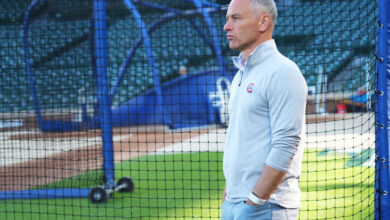
Cubs Believe Lack of Deception Fueling Ryan Pressly’s Poor Performance
Cubs closer Ryan Pressly has completed only 13 innings in 14 appearances, with a balky right knee keeping him from throwing more regularly of late. And though the team says he’s healthy and feeling good after having his knee drained prior to the Phillies series, the results tell us something is amiss. And I’m not talking about the most obvious example from Tuesday’s implosion against the Giants that saw Pressly surrender nine runs in the 11th inning without retiring a batter.
What’s more concerning to me is the fact that he simply isn’t missing bats with nearly enough frequency to handle high-leverage situations. His changeup has generated no whiffs after being north of 30% in previous seasons, and his fastball is at just 3.0% against 18.1% last season. He’s generated just one swing and miss over the last two games and has just five total strikeouts to eight walks on the season.
The only thing that may be keeping Pressly from looking far worse is a 56.3% grounder rate that is among the best in baseball.
He currently sits in the 1st percentile among MLB pitchers in strikeout rate (8.1%), whiff rate (14.4%), and hard-hit rate (56.3%), with several other single-digit ranks in other categories. Out of 205 relievers with at least 10 innings pitched this season, only two (T.J. McFarland, 4.9%; Angel Zerpa, 4.2%) have managed lower than Pressly’s 5.7% swinging-strike rate. And they’ve got only one career save between them, with McFarland successfully closing a game for the Diamondbacks in 2018.

Even accounting for Tuesday’s aberration, all signs point to Pressly needing to dramatically improve his performance in order to hold down a spot at the back end of the bullpen. Several factors feed into his alarming results, but pitching coach Tommy believes the root cause is something we can’t see in Baseball Savant’s percentile rankings or movement profile.
“I believe in deception factors that don’t maybe show up in normal mechanical breakdowns or even in pitch data,” Hottovy told Sahadev Sharma and other reporters. “He can have good pitch data, but I do believe there are some mechanical things that hitters are just seeing the ball a little early. When you can have good pitch data, good velocity, but a hitter sees it a tick early, whether it’s subconscious or they’re actually picking it up, it just gives them more time.”
The Cubs don’t believe it’s an issue of Pressly having a tell, and it’s certainly not like Ben Brown basically throwing only two pitches and having hitters guess right too often. Rather, it could be a matter of Pressly altering his mechanics ever so slightly to let opposing hitters see the ball a fraction of a second sooner.
“Tipping would be more where they literally know what’s coming,” Hottovy explained further. “We’re on top of making sure that’s not happening. He’s very astute of what he’s doing. Not to say there aren’t minor things that pop up. But I’m thinking more about how the delivery happens. When a guy’s front shoulder flies open early, that shows the hitter and gives them more time.”
Decreased velocity almost certainly plays a role there, as may a curveball that has gotten slurvier over the years. Breaking stuff has been Pressly’s calling card and his slider has maintained a pretty consistent movement profile, but his curve has gone from 14-15 inches of horizontal break to nearly 17 this season. Between the deviations in shape and velocity, hitters might be better able to discern what’s coming and spit on the curve in particular.

The idea that Pressly is flying open explains the increased horizontal movement on the curve, and it might show up even more clearly in the fastball. The four-seam has generated arm-side movement in every season dating back to 2015, varying from 0.2-3.2 inches of run. This season, however, it’s getting a full inch of glove-side cut. I don’t know how much that shift is impacting his results in and of itself, but it sure seems like a symptom of other mechanical issues.
If there’s a positive takeaway here, it’s that Hottovy and the Cubs appear to have identified the issue early enough to course-correct. It took much longer for them to identify a similar flaw in Jameson Taillon‘s delivery during his Cubs debut season in 2023, so there’s still plenty of time for Pressly to course-correct. That includes staying healthy and having time to eliminate some bad habits that may have formed while he was trying to pitch through the knee issue.
In the meantime, it might be in the team’s best interest to have the closer work in lower-leverage settings while giving save opportunities to Porter Hodge.
“There’s going to be opportunities where ‘Hey, if you haven’t thrown in a couple days, we need to get your work day in,’” Hottovy said. “It might not be a high-leverage situation, but we need to get the reps, because he’s going to be better down the road by pitching more. We just gotta kind of figure out how to navigate that in a series.”

